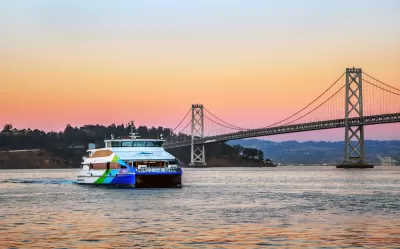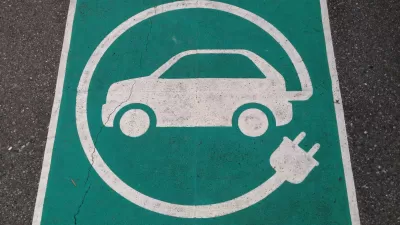While battery-power doesn't appear practical, electricity from fuel cells does. The nation's first fuel cell-powered ferry will be operating in San Francisco Bay next year thanks in part to a $3 million grant from the California Air Resources Board.

Several years ago, Tom Escher, owner and president of San Francisco-based-Red and White Fleet, a cruise tour operator in San Francisco Bay since 1892, approached Sandia National Laboratory in Livermore (Alameda County), operated for the U.S. Department of Energy’s National Nuclear Security Administration, with the idea "to run his entire fleet of sightseeing and charter ferries with a zero-emissions fuel," reports Erin Baldassari of the Bay Area News Group on June 25.
Under the leadership of Joe Pratt, an expert in zero-emission hydrogen fuel cell maritime technology, Sandia agreed "to design, build, and operate a high-speed hydrogen fuel cell passenger ferry and hydrogen refueling station," according to the company (posted here in August 2015). The proposal won a $500,000 grant from the U.S. Department of Transportation's Maritime Administration (MARAD) to pay for a feasibility study of the project, which would allow for refueling of land-based fuel cell vehicles.
The study [pdf], released in September 2016, concluded that, "yes, it is possible from a regulatory and technical standpoint, but costly," reported Baldasari on November 14, 2016. "[T]o ensure the project moves forward, the Maritime Administration awarded Sandia a second $250,000 grant to further optimize the design and bring down both the capital and operating expenses."
Fast-forward to last Monday, June 25, when "Pratt’s newly formed company, Golden Gate Zero Emission Marine, announced it had won a $3 million grant from the California Air Resources Board that will be administered through the Bay Area Air Quality Management District to make Escher’s dream a reality," adds Baldasari. The project, named Water-Go-Round, was among many zero-emission applications sharing $20 million in California Climate Investments, a statewide program that puts billions of Cap-and-Trade dollars to work reducing greenhouse gas emissions.
"Pratt’s company, founded last year, won’t become a shipbuilder, he said, reports David Baker for the San Francisco Chronicle. "Instead, it plans to develop and sell the drivetrain technology that can be added to new or existing boats." The ferry will be built in Alameda at Bay Ship & Yacht Co.
The boat should hit the waters of San Francisco Bay in autumn 2019. Red and White Fleet will operate it, while Sandia studies its performance.
Sandia will forward its findings to the California Air Resources Board, which will use the information to gauge how well fuel cells function in boats.
When launched, "it will be the first fuel cell vessel in the US and the first commercial fuel cell ferry in the world," according to the Water-Go-Round Project Team.
Baker explains why electricity produced from fuel cells using hydrogen fuel, rather than plug-in batteries used in light and heavy-duty vehicles, including buses, is preferable for marine transportation to achieve zero-emissions. Most of the California Climate Investment grants awarded on June 25 went to battery-electric applications.
No hydrogen refueling station
One part of the original proposal was to include a hydrogen refueling station that could be used for fuel cell vehicles like the Honda Clarity sedan and the Toyota Mirai. However, those motorists won't be able to fill their hydrogen tanks at the dock because there won't be a conventional station, writes Baldassari.
No dock-side fueling stations will be needed; Pratt said a hydrogen fueling truck will be able to drive onto the dock and refuel the boat straight from the truck. And, as the price of wholesale hydrogen fuel continues to drop while diesel prices climb, Pratt said it will only be a few years until hydrogen fuel is cheaper..
As for the nearly 5,000 fuel cell passenger vehicles motoring in the Golden State, according to the California Fuel Cell Partnership as of June 6, they can refuel at "33 hydrogen stations clustered largely in the Bay Area and Los Angeles, with outposts in Tahoe, Sacramento and the Central Valley," adds Baldassari.
FULL STORY: Nation’s first hydrogen fuel-cell ferry to be built in Bay Area

Planetizen Federal Action Tracker
A weekly monitor of how Trump’s orders and actions are impacting planners and planning in America.

Maui's Vacation Rental Debate Turns Ugly
Verbal attacks, misinformation campaigns and fistfights plague a high-stakes debate to convert thousands of vacation rentals into long-term housing.

Restaurant Patios Were a Pandemic Win — Why Were They so Hard to Keep?
Social distancing requirements and changes in travel patterns prompted cities to pilot new uses for street and sidewalk space. Then it got complicated.

In California Battle of Housing vs. Environment, Housing Just Won
A new state law significantly limits the power of CEQA, an environmental review law that served as a powerful tool for blocking new development.

Boulder Eliminates Parking Minimums Citywide
Officials estimate the cost of building a single underground parking space at up to $100,000.

Orange County, Florida Adopts Largest US “Sprawl Repair” Code
The ‘Orange Code’ seeks to rectify decades of sprawl-inducing, car-oriented development.
Urban Design for Planners 1: Software Tools
This six-course series explores essential urban design concepts using open source software and equips planners with the tools they need to participate fully in the urban design process.
Planning for Universal Design
Learn the tools for implementing Universal Design in planning regulations.
Heyer Gruel & Associates PA
JM Goldson LLC
Custer County Colorado
City of Camden Redevelopment Agency
City of Astoria
Transportation Research & Education Center (TREC) at Portland State University
Jefferson Parish Government
Camden Redevelopment Agency
City of Claremont




























